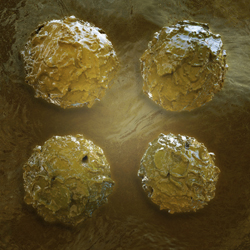Enhancing human stem cell culture
The reagents used in hESC cultivation and storage need to be biochemically defined and contaminant-free. It is equally important that new methods and tools have no undesirable effects such as induction of genetic instability, and that they can be automated. The goal of the EU-funded 'Biochemically equivalent substitutive technology for stem cells' (BEST-STEM CELLS)(opens in new window) project was the development of new knowledge and reagents for hESC culture. Research was predominantly focused on pluripotent hESC culture but also addressed multipotent human mesenchymal stem cell (hMSC) culture. The consortium was composed of eight academic and commercial partners across five EU Member States. Researchers achieved remarkable progress in their mission over the three-year duration of the project. They created polymer substrates supporting the attachment and growth of hESCs and hMSCs, from which cells could be gently dissociated by lowering ambient temperature. This represents an alternative to current requirements for animal tissue-derived substrates, and harsher methods of cell dissociation with the potential for damaging cells. Scientists determined and validated the synthetic small molecules for growing hESCs and hMSCs by replacing or reducing current requirements for protein growth factors and serum supplements. Recombinant proteins (either high-affinity or membrane-permeant) affecting hESC survival and growth were also developed and validated. Finally, researchers defined conditions for a serum-free cryopreservation protocol for hESCs and identified cryo-protective agents of non-vertebrate origin. During the course of the project, partners communicated ongoing research progress at international and national meetings, invited lectures and public forums, cumulatively totalling 61 engagements in 10 countries. Press releases were issued in association with high-profile accomplishments, most notably the communication of the hESC-supportive thermomodulatable hydrogels. Several high impact factor papers were published presenting the results of the project. It is very important that BEST-STEM CELLS outcomes support the ongoing international commitment to the use of hESCs in research, industrial and clinical applications. An additional benefit would be the parallel and growing developments of induced pluripotent stem cells in these contexts as well.







